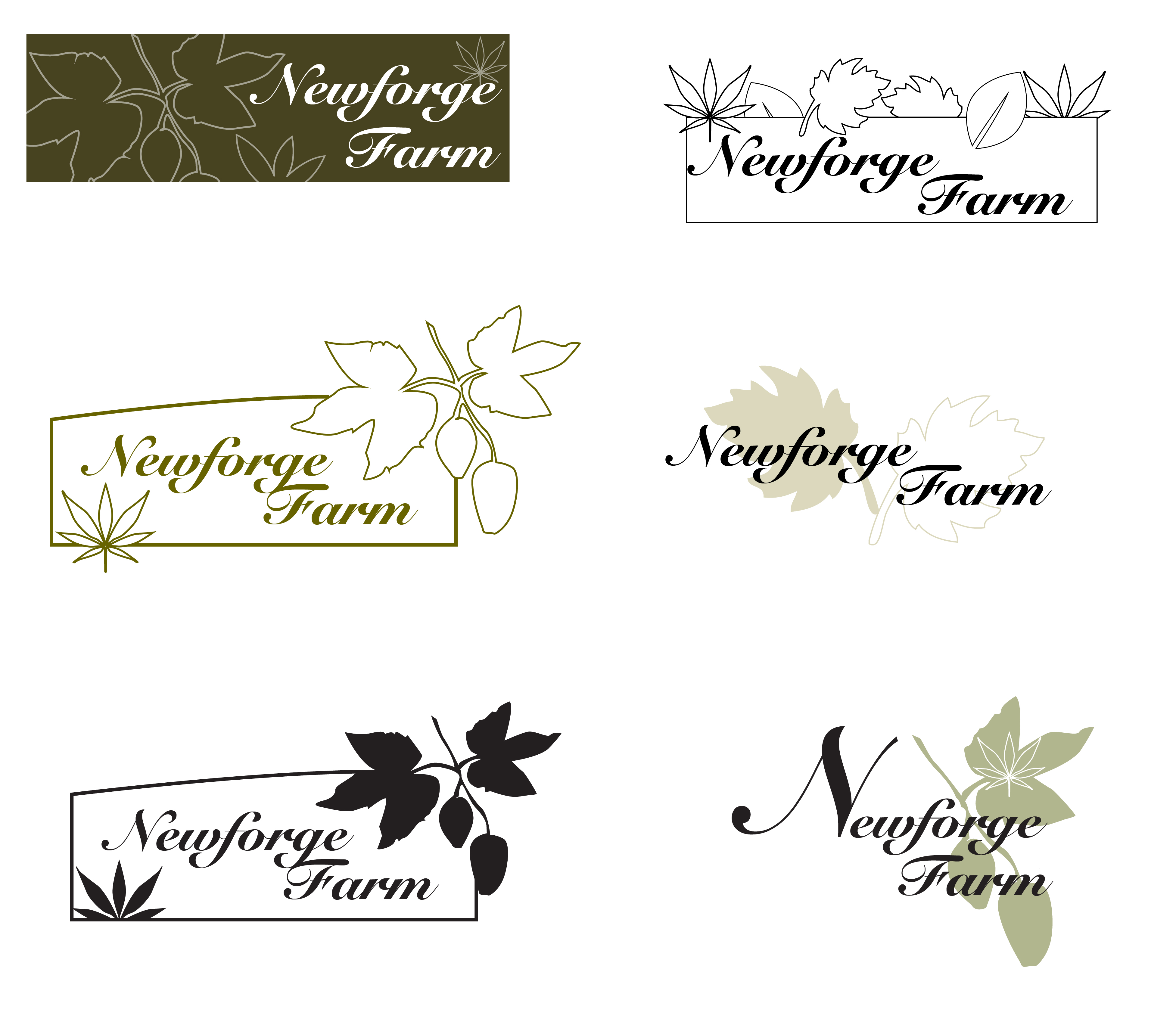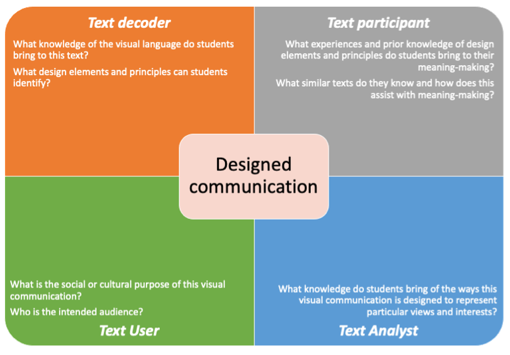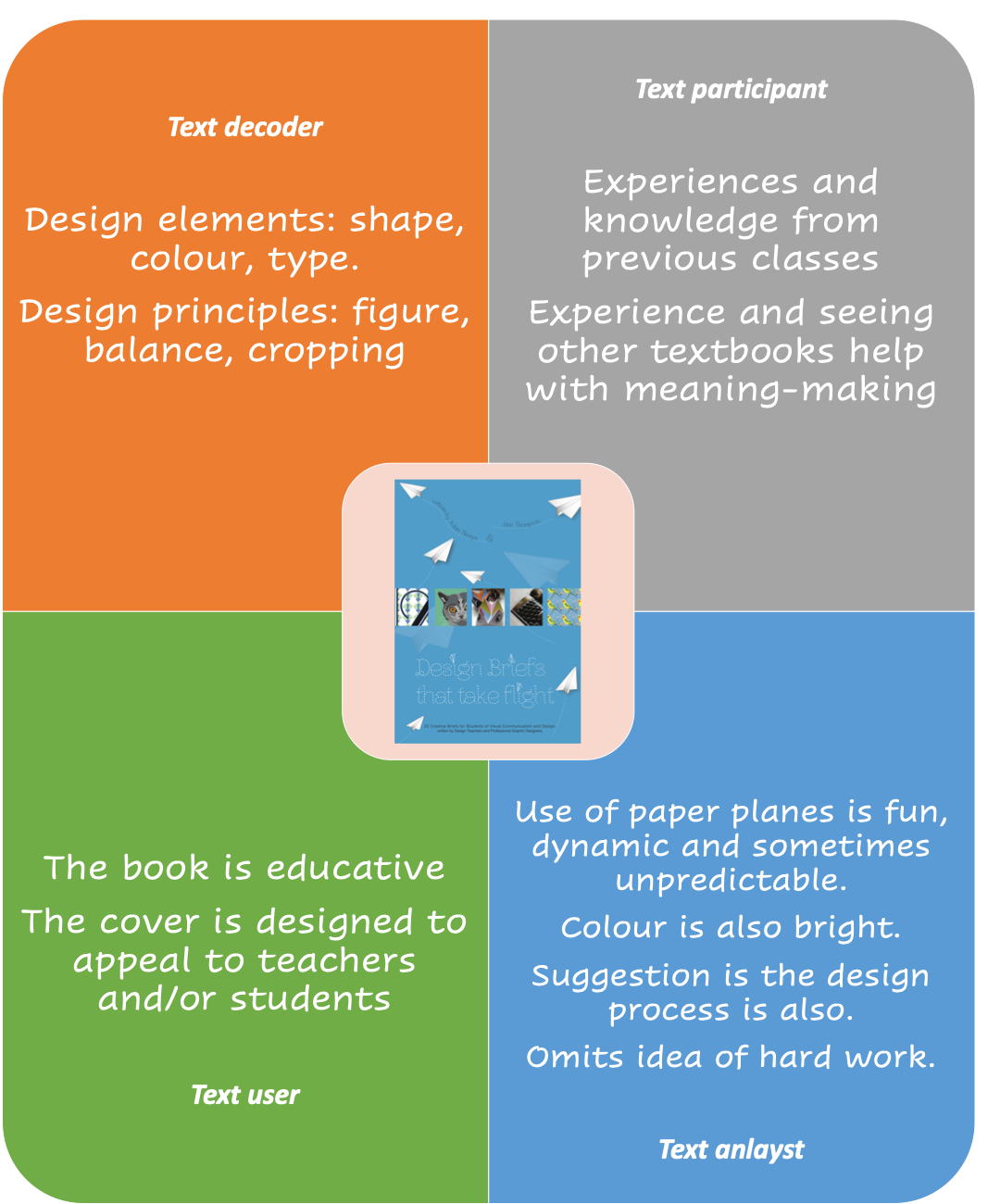In VCD, students must
- view imagery, symbols, and visual codes
- interpret and analyse their meaning, purpose and how their arrangement is intended to impact a target audience.
Students need knowledge of visual meaning-making systems to understand how visual communications represent and construct meaning (Unsworth & Wheeler, 2002).
Two strategies teachers can use to support students to analyse designed visual communications are:
Using literal, inferential, and evaluative questions to analyse a designed communication
Using the Four Resources Model to analyse visual communication and design
Another way teachers can jointly deconstruct an image or artwork is by using
literal, inferential and evaluative questions. The three types of questions help to scaffold students' viewing and interpretation of the artwork.
These questions can be used to encourage students to discuss target audience, purpose, and presentation formats for designed communications. This will further aid student understanding in the language used to effectively analyse visual communications.
The examples below demonstrate how literal, inferential and evaluative questions can be applied to a series of proposed logos for a restaurant, Newforge Farm.

- What are the methods, media and materials used in each example?
Literal: in the text
- For the online Newforge logo, the method is digital, the media is a raster-based program (Photoshop), the material is the screen.
- If the selected logo were to be printed, the method would be print, the media is ink or toner, and the material would be paper or card.
- Considering the methods, media and materials used, what is the audience and purpose for each example?
Inferential: implied in the text
- The six different logos are proposals, so the audience would be the owner/s of Newforge Farm. The purpose is to show all the proposed logos together to allow the owner/s to choose their preferred logo.
- If one logo were to be selected, the audience would be potential customers, and the purpose is to attract them to the restaurant.
- Consider the context and purpose of each example. Why might these methods, media and materials have been used in each? Do you think the methods, media and materials used are appropriate for the audience, purpose and context?
Evaluative: beyond the text
- For both the proposals and selected logo, a digital presence is important for new businesses, so digital images are useful for websites and social media. The materials and methods are appropriate for the intended audience. The chosen colour schemes are earth tones, which suggests organic, healthy food. This is reinforced by the images of leaves.
Curriculum links for the above example:
VCAVCDR004,
VCAVCDR005,
VCAVCDR010,
VCAVCDR011.
Another way to support students to develop their understanding of how to analyse designed communications is to use the Four Resources Model.
The Four Resources Model (Freebody & Luke, 1990) may be used as a framework to identify, analyse and evaluate design elements and principles in visual communications. The Four Resources Model (or four roles of the reader) was originally developed as a model for effective reading. The Model draws upon a repertoire of practices and resources that enable students to:
- break the code of texts:
Text decoder
- participate in the meanings of text:
Text participant
- use texts functionally:
Text user
- critically analyse and transform texts:
Text analyst
(Freebody & Luke, 1990).
Since its first conceptualisation, The Four Resources Model has been adapted and used as a model for making meaning from and creating texts in different modes (Luke & Freebody, 1999; Serafini, 2012).
The following outline suggests how the Model may be used in the interpretation and analysis of visual communication design.
Text decoder
When reading visual and multimodal texts, decoding involves understanding and 'cracking the codes' of the elements, principles, structures, and codes associated with visual communication design in specific contexts (Kress & van Leeuwen, 1996; Serafini, 2012).
Text participant
Participating in and interpreting visual communications involves making meaning from and composing texts drawing on prior knowledge and experience of similar texts. Interpreters of visual communications and design construct meaning by drawing on their knowledge of design elements and principles, their experience of other visual texts and their historical and cultural understandings (Luke & Freebody, 1999; Serafini, 2012).
Text user
Text users understand that texts and communications are used for functional, social, and cultural purposes in particular contexts. In VCD, using (and creating) texts functionally involves understanding how visual communications are designed for audiences and purposes.
Text analyst
This role involves critically analysing or 'interrogating' texts. The text analyst understands that texts are not neutral and that they represent particular views and omit other perspectives. In VCD analysis, understanding the context, purpose and intended audience of visual communications is important. Critical analysis also involves identifying values and ideology and systems of belief in visual communications as "images are important means through which ideologies are produced and … projected" (Sturken & Cartwright, 2001, p. 21). Visual communications, like other texts, position viewers in particular ways.
The following strategy draws on the Four Resources Model as students deconstruct visual communications in preparation for written and oral analyses.
- The teacher presents a visual communication design to students, for example, a proposed book cover.

- The teacher asks students if they recognise the image, who it depicts, and the context of the design to ascertain students' existing knowledge.
- The teacher introduces the Four Resources Model, explaining the various positions readers can adopt when reading a text
- The teacher presents students with a concept map or table, with questions that help students adopt one of the four roles to read the text.

See: Four models template
- The above process may be organised as joint deconstruction with teacher leading students or in small student groups.
- Students record their ideas and notes in response to the question prompts, and from group discussion, in the graphic organiser for each of the four roles.
- Alternatively, teachers could restructure this activity as a jigsaw, so that students work in groups of four, each group focussing on one of the four roles, and then reorganised groups share the different readings of the text.


- The teacher leads the discussion during which students present their responses.
- The teacher guides students to research more information about this text. Research might include finding more information about:
- the designer
- the context in which the design was produced
- the theme/subject matter of the communication
- public/audience response to the communication
- replications/reproductions/adaptations of the communication.
- Students use their research to extend notes.
- The teacher asks students about how this strategy has enhanced their understanding of:
- the use of design elements and principles
- how design elements and principles create certain meaning and impact
- the ways in which designers draw on other visual texts and iconography to create meaning and impact
- how visual communications represent particular perspectives for specific audiences, purposes and context.
Curriculum links for the above example:
VCAVCDR004,
VCAVCDR005,
VCAVCDR010,
VCAVCDR011.